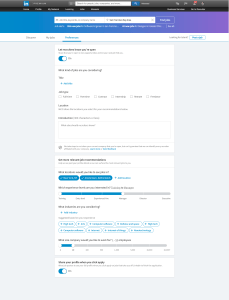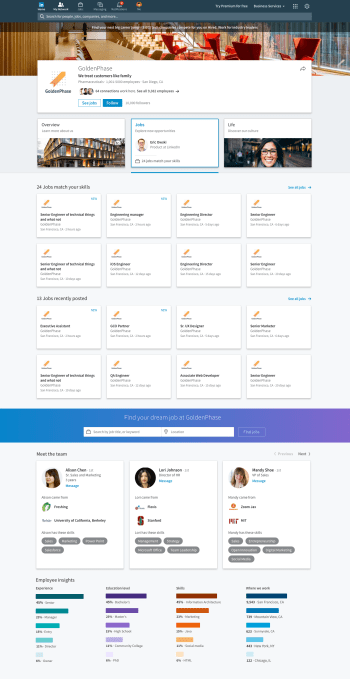One of the hallmarks of any social network is how it pushes people to share their experiences with others, but increasingly we’ve seen a lot of moves by social platforms to give people the option to remain very private, if they choose.
One of the latest moves on this front comes from LinkedIn, the social network for the working world with some 450 million members and currently getting acquired by Microsoft for $26.2 billion: today the company is turning on a new feature for its users who may be interested in quietly looking for a new job, while still employed somewhere else.
Open Candidates, as the new feature is called, will let those users essentially create a signal that will be viewable only to recruiters who use LinkedIn’s premium (paid) tier of service (prices begin at $8,000 and vary depending on the number of licenses). In turn, those recruiters who are looking for candidates like that person will get a signal that a particular candidate is looking to change jobs and is open to getting contacted about new career opportunities. It will be initially available in the US, Canada, UK, and Australia and will get rolled out to more markets throughout this year, LinkedIn tells me.

Open Candidates is being turned on as part of a larger revamp of LinkedIn’s recruitment products, which also include new and more dynamic Career Pages — customised pages that companies that are recruiting employees use to advertise themselves — and a new way for recruiters to connect at the backend with their clients who are hiring to provide more seamless integration. Both of these are getting rolled out globally from today.
All three are being unveiled formally today at the company’s annual Talent Connect event.
Open Candidates and the other two updates are much-needed (and perhaps overdue) features for LinkedIn. Talent Solutions — the company’s recruiting operations — accounts for the lion’s share of the company’s revenues (last quarter bringing in $558 million of its $861 million in sales), but at the same time it’s facing a lot of heat from old behemoths like Indeed and Monster, as well as newer and more nimble approaches from the likes of Glassdoor, all of whom are also vying for the same online job advertising market. LinkedIn’s recruiting business, which today lists some 6 million jobs, needs updating and innovating all the time to stay competitive.
Of the three, Open Candidates is perhaps the most interesting update getting announced today.
In terms of social networks, LinkedIn holds a unique place in the market for how it has approached the idea of watching and being watched.
The company regularly tracks and updates users on who is viewing their profiles and other stats about their presence on the platform, essentially applying some of the mechanics of things like ad tech to its platform to highlight relationships and build connections. You can opt out of being tracked this way, and also from seeing these stats, but even if you don’t want to look or be seen, that information is still being tracked.
Features like this have been a blessing (some people love these things) and a curse (some find it creepy). But to me, Open Candidates is possibly one of the most practical and helpful applications of some of LinkedIn’s technology. The company is embracing one of the main ways that its platform is used today — to look for jobs, or to find people to fill jobs — and it is making it easier for people to do this now in a more discreet way.
And for some it might make LinkedIn a more friendly platform to use for other things. I’ve seen countless people note on their LinkedIn profiles that they do not, under any circumstances, want to get contacted by recruiters on there. The fact that people have had to put this on their profile pages is a sign of how annoying LinkedIn can be for some. If the Open Candidates feature gets used as it should, some of that spammy element could start to subside.
There are some interesting and very useful details for how it works. Dan Shapero, LinkedIn’s Careers product lead, told me that if you turn on Open Candidates, the “looking for new work” signal will only be beamed out to recruiters who are not in any way connected to the place where you currently work. That means that even if you are looking, you won’t jeapordize your current job in the process. You can then share your profile with that recruiter privately, too.
And LinkedIn, like other social networks, is always looking for ways of getting people to share more of their details and keep them up to date. This applies here, too. Once you turn on the feature that will privately let recruiters know you are looking for work, the company will give you an opportunity to revisit and update your own profile.

While less impactful for the wider population on LinkedIn, the Career Pages update helps to lay the groundwork for how LinkedIn wants to continue growing its recruitment business.
The new pages will now add significantly more conversational testimonials and other social features to company’s recruitment sites, making them more about trying to convey a company’s culture rather than simply the jobs that are on offer at the moment.
This is an interesting turn and to me really shows the influence of sites like Glassdoor on the recruiting market today. It may not feel like this to everyone in the world (some will take any work they can get), but a lucky proportion of the population has a choice about where she or he can take a job.
LinkedIn’s updates cater to that idea by helping companies create pages that give candidates a better idea of what the company is actually like, to see if it’s the kind of place where you might like to be. In the words of product manager Eric Owski, it’s “not about selling the company, but how we think.”
Still, it is a decidedly positive spin. No candid reviews from disgruntled employees, the updated Career Pages will bring in posts from existing employees that are getting published on LinkedIn, as well as a selection of profiles of other people from the company, alongside job listings.
As with the new Open Candidates feature, the new Career Pages will be made available to paying companies — with a more pared-down version still available to use for free.
